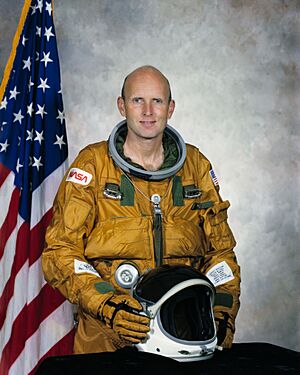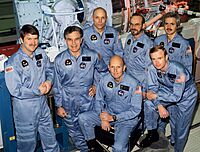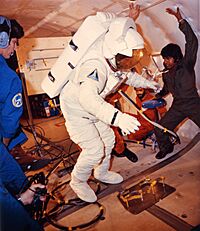C. Gordon Fullerton facts for kids
Quick facts for kids
Gordon Fullerton
|
|
|---|---|

Fullerton in 1979
|
|
| Born |
Charles Gordon Fullerton
October 11, 1936 Rochester, New York, U.S.
|
| Died | August 21, 2013 (aged 76) Lancaster, California, U.S.
|
| Awards | Distinguished Flying Cross NASA Distinguished Service Medal |
| Space career | |
| NASA astronaut | |
| Rank | Colonel, USAF |
|
Time in space
|
15d 22h 50m |
| Selection | USAF MOL Group 2 (1966) NASA Group 7 (1969) |
| Missions | ALT STS-3 STS-51-F |
|
Mission insignia
|
   |
| Retirement | December 31, 2007 |
Charles Gordon Fullerton (born October 11, 1936 – died August 21, 2013) was an amazing American pilot and astronaut. He was a United States Air Force colonel and flew for both the Air Force and NASA. Later, he became a research pilot at NASA's Dryden Flight Research Facility in California.
Gordon Fullerton spent over 380 hours flying in space. He was a NASA astronaut from 1969 until 1986. After that, he became a research pilot for NASA as a civilian. He retired from the U.S. Air Force in 1988 as a colonel. Fullerton lived in Lancaster, California, with his wife and two children.
Contents
Gordon Fullerton: A Life in Flight
Early Life and School
Gordon Fullerton was born on October 11, 1936, in Rochester, New York. He went to Ulysses S. Grant High School in Portland, Oregon, and finished in 1953. He then studied at the California Institute of Technology in Pasadena, California. He earned two degrees in mechanical engineering in 1957 and 1958.
Air Force Adventures
Before joining the Air Force, Fullerton worked as an engineer for Hughes Aircraft Company. In July 1958, he joined the U.S. Air Force.
He trained to fly different types of planes. First, he flew the F-86 interceptor, a fast jet for stopping enemy planes. Then, he became a B-47 bomber pilot. In 1964, he was chosen for the Air Force Test Pilot School. This school teaches pilots how to test new aircraft.
In 1966, Fullerton was picked for the Air Force's Manned Orbiting Laboratory (MOL) program. This was a secret project to send military astronauts into space. The program ended in 1969 before any missions flew.
Becoming a NASA Astronaut
After the MOL program ended, Fullerton joined NASA in September 1969. He became part of NASA Astronaut Group 7. As an astronaut, he helped prepare for the Apollo 14, 15, 16, and 17 missions to the Moon. He was part of the "support crews," helping the main astronauts with their training and mission plans.
In 1977, Fullerton got to fly the Space Shuttle prototype Enterprise. This was during the Approach and Landing Tests (ALT) program. These tests showed that the Space Shuttle could fly like a plane and land safely.
Fullerton was the pilot for the STS-3 Space Shuttle mission. This flight happened from March 22 to 30, 1982. The mission used the orbiter Columbia. They tested how the shuttle handled extreme heat and cold in space. They also tested the 50-foot (15 m) long Canadarm. This robotic arm is used to grab and move things in space.
Fullerton was also the commander of the STS-51-F "Spacelab 2" mission. This mission launched on July 29, 1985, using the orbiter Challenger. It carried 13 main experiments. These experiments studied stars, the Sun, Earth's atmosphere, and even how liquids behave in space. The mission landed on August 6, 1985.
Testing New Aircraft
After his space missions, Fullerton became a research test pilot. He flew many different experimental aircraft.
He was a project pilot for the NASA/Convair 990 plane. This plane was changed to test parts of the Space Shuttle's landing gear. He also worked on the F-18 Systems Research Aircraft. This jet was used to test new flight control systems.
Fullerton also worked on the Propulsion Controlled Aircraft program. He showed that he could land an F-15 jet and an MD-11 plane using only the engines. This was amazing because the normal controls were not working.
He flew the B-52 launch aircraft for many tests. This included testing a new way to rescue the crew from an F-111 jet. He also flew the B-52 to launch the Pegasus space vehicle from the air.
Fullerton was one of two NASA pilots who flew the Russian-built Tu-144LL supersonic aircraft. This was part of a research program to study high-speed flight.
Gordon Fullerton flew over 16,000 hours in his career. He piloted 135 different types of aircraft! These included many famous jets like the T-33, F-14, and X-29.
Later Years
Fullerton retired in 2007. He became ill in 2009 and passed away on August 21, 2013, at the age of 76.
Awards and Honors
Gordon Fullerton received many awards for his bravery and skill.
Military and Government Awards
| Defense Distinguished Service Medal | |
| Defense Superior Service Medal | |
| Distinguished Flying Cross | |
| NASA Distinguished Service Medal | |
| NASA Exceptional Service Medal | |
| NASA Space Flight Medal (1983 and 1985) |
Other Special Recognitions
- Iven C. Kincheloe Award from the Society of Experimental Test Pilots, 1978
- Inducted into the United States Astronaut Hall of Fame in 2005
- General Thomas D. White Space Trophy, 1977
- Haley Space Flight Award from the American Institute of Aeronautics and Astronautics
- Golden Plate Award of the American Academy of Achievement, 1982
- Certificate of Achievement Award from the Soaring Society of America
- Ray E. Tenhoff Award from the Society of Experimental Test Pilots in 1992 and 1993.
- Fellow of the Society of Experimental Test Pilots
- Member, Tau Beta Pi (an engineering honor society)
- Honorary member of the National World War II Glider Pilot Association
- Fellow of the American Astronautical Society
In 1982, Fullerton and his STS-3 crewmate, Jack Lousma, were inducted into the International Space Hall of Fame. They also received the Pioneer Award for their work on the STS-3 mission.
Sources
- Biography of C. Gordon Fullerton




